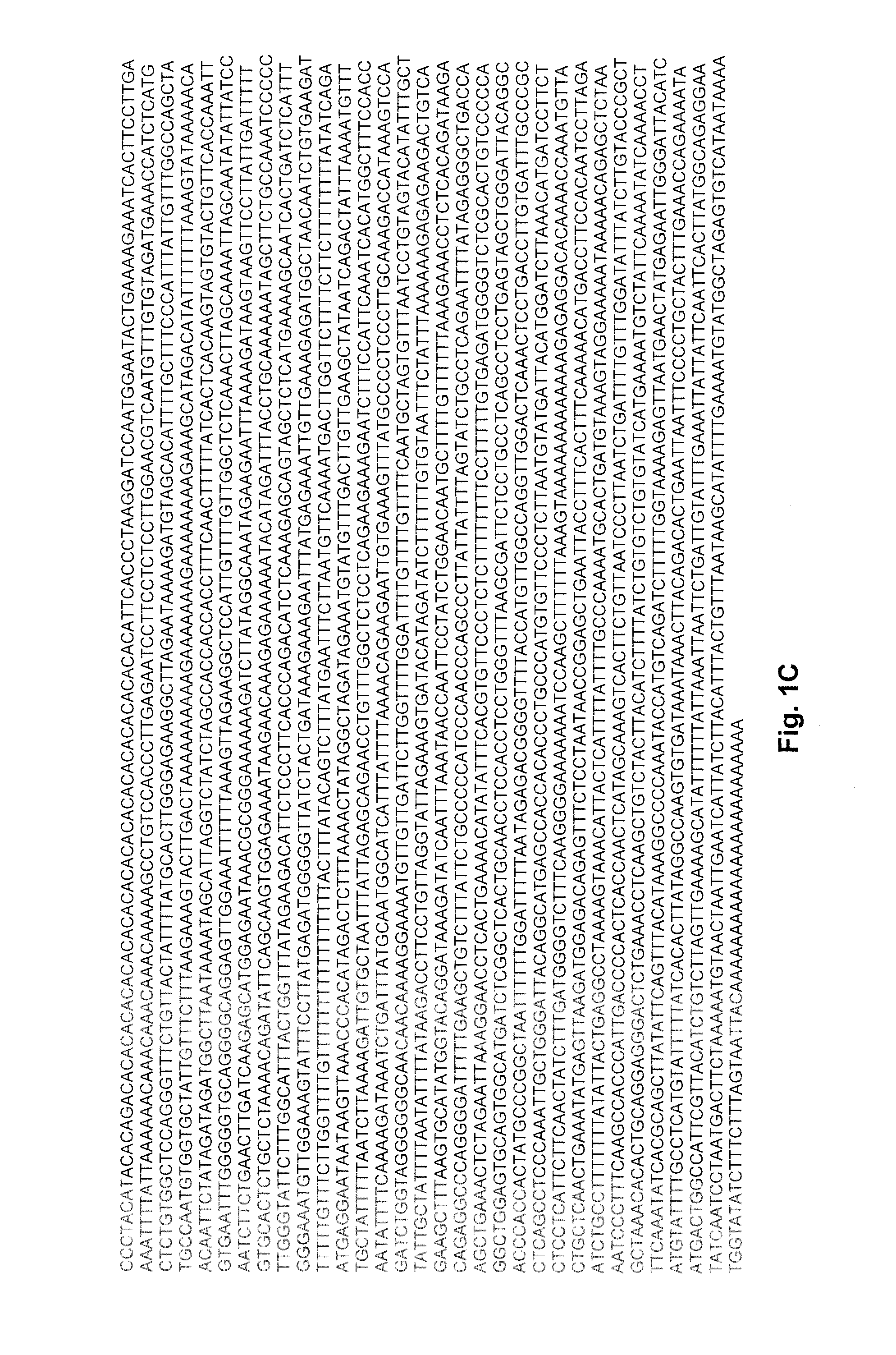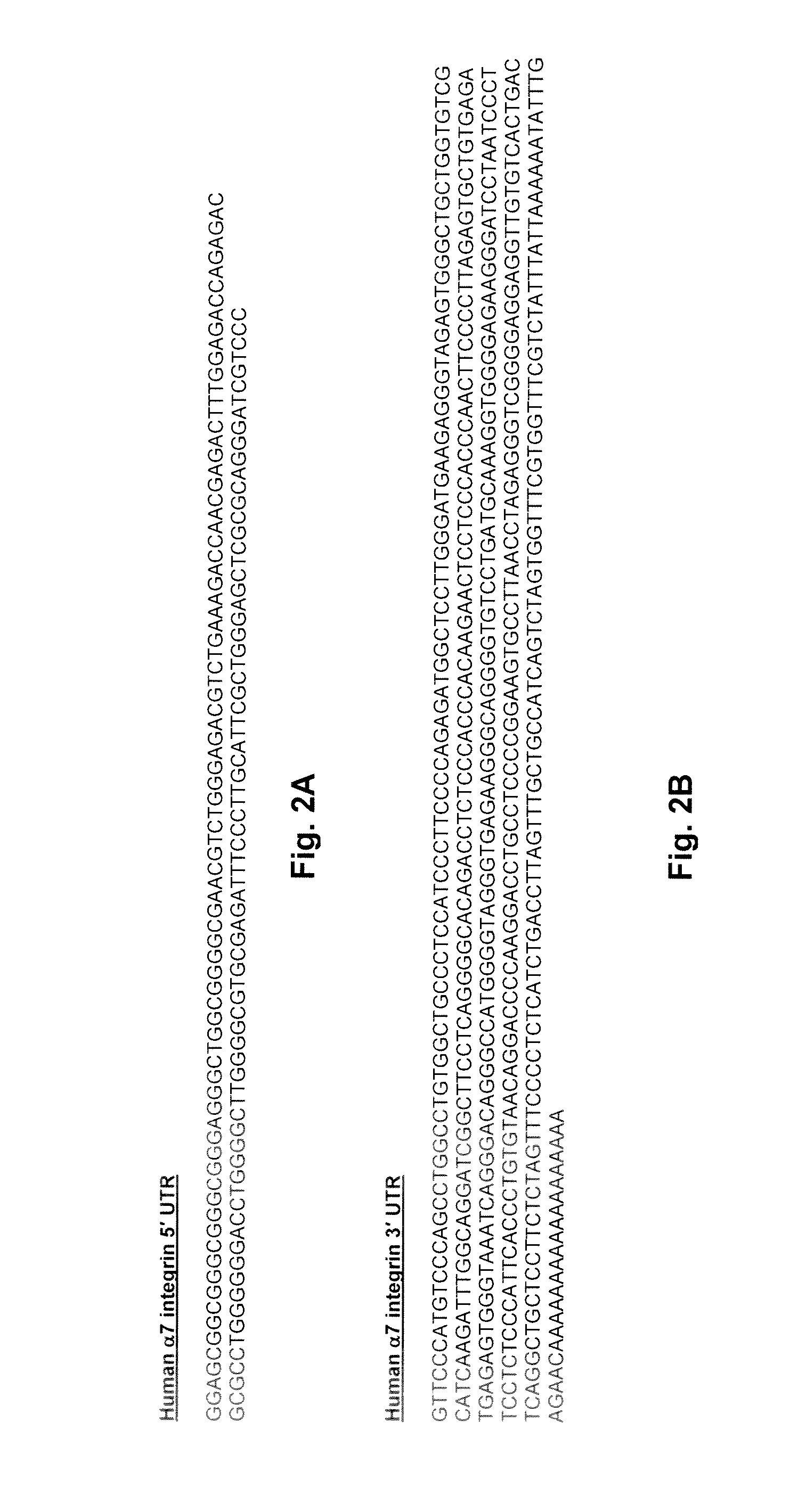[0011]Embodiments of the present invention include a method for treating MD or a form thereof mediated by selectively increasing the endogenous production of mIGF1, ITGA7, or UTRN protein using compounds that target the UTRs of the corresponding mRNA transcripts. Such compounds can be used in a method for the treatment of MD or a form thereof, preferably DMD and BMD, in human subjects in need thereof. Compounds that modulate any of the 5′-UTR and 3′-UTR, the 5′-UTR or the 3′-UTR of a target mRNA (i.e., mIGF1, ITGA7, or UTRN) and up-regulate, increase or enhance expression of the target protein (i.e., mIGF1, ITGA7, or UTRN) can be used in therapeutic regimens for the treatment of MD, preferably DMD, in human subjects in need thereof.
[0018]The UTR targeted approach of the invention has several advantages. In particular, the sequences of the 5′-UTR and 3′-UTR appear to be unique to each of the transcripts (i.e., mIGF1, ITGA7, or UTRN). Therefore, compounds that are highly specific for these UTRs (i.e., mIGF1, ITGA7, or UTRN), can be used to selectively up-regulate post-transcriptional expression of the target gene (i.e., mIGF1, ITGA7, or UTRN). Further, up-regulating the post-transcriptional expression of the mIGF1, ITGA7, or UTRN gene selectively targets only cells that contain the mIGF1, ITGA7, or UTRN mRNA transcripts, respectively. The use of such compounds in the methods of the invention should, therefore, have reduced side effects to non-specific targets and cells. Moreover, the UTR targeted approach of the invention exploits the endogenous regulatory elements of mIGF1, ITGA7, or UTRN expression, thus, avoiding many technical, safety, and efficacy issues involved with other therapeutic approaches envisioned for the treatment of MD or a form thereof, e.g., genetic approaches to deliver DNA encoding therapeutic genes or to modify endogenous mutated genes. Thus, the methods of the present invention offer several advantages, in terms of increased specificity and efficacy and reduced side effects.
[0019]Without being bound by any particular theory, the compounds that target any of the 5′-UTR and 3′-UTR, the 5′-UTR or the 3′-UTR of the target mRNA (i.e., mIGF1, ITGA7, or UTRN), when used therapeutically, may increase expression of the target in patients with MD and certain forms thereof, particularly DMD or BMD, and reduce, ameliorate or prevent skeletal muscle degeneration. Thus, the present invention is directed to a method for up-regulating the expression of a target (i.e., mIGF1, ITGA7, or UTRN) protein in a human subject in need thereof, comprising administering an effective amount of a compound to the human subject, which compound has demonstrated activity for enhancing post-transcriptional expression of a nucleic acid construct comprising a reporter gene operably linked to any of the 5′-UTR and 3′-UTR, the 5′-UTR or the 3′-UTR of the target (i.e., mIGF1, ITGA7, or UTRN) in vitro or in cultured cells.
[0040]As used herein, the term “effective amount” in the context of administering a compound to a subject refers to the amount of a compound which is sufficient to achieve at least one or more of the following effects: (i) reduce or ameliorate the severity of MD or a form thereof or a symptom associated therewith; (ii) prevent the progression of MD or a form thereof or a symptom associated therewith; (iii) cause regression of MD or a form thereof or a symptom associated therewith; (iv) prevent the development or onset of MD or a form thereof or a symptom associated therewith; (v) prevent the recurrence of a symptom associated with MD or a form thereof; (vi) reduce the loss of muscle strength; (vii) reduce the loss of muscle cells; (viii) enhance or improve muscle strength; (ix) increase muscle cells; (x) reduce muscle dystrophy; (xi) increase motor function; (xii) reduce the duration of a symptom associated with MD or a form thereof; (xiii) reduce the number of symptoms associated with MD or a form thereof; (xiv) reduce hospitalization associated with MD or a form thereof in a subject; (xv) reduce hospitalization length associated with MD or a form thereof; (xvi) increase the survival of a subject having MD or a form thereof; and (xvii) enhance or improve the prophylactic or therapeutic effect(s) of another agent.
[0050]As used herein, the term “synergistic,” refers to the effect of the administration of a combination product as described herein which is more effective than the additive effects of any two or more single agents. In a specific embodiment, a synergistic effect of a combination product permits the use of lower dosages of one or more agents and / or less frequent administration of said agents to a subject with MD or a form thereof. In certain embodiments, the ability to utilize lower dosages of an agent and / or to administer said agents less frequently reduces the toxicity associated with the administration of said agents to a subject without reducing the efficacy of said agents in the prevention or treatment of MD or a form thereof. In some embodiments, a synergistic effect results in improved efficacy of each of the agents in treating MD or a form thereof. In some embodiments, a synergistic effect of a combination of agents avoids or reduces adverse or unwanted side effects associated with the use of any single agent. The combination of agents in such a product can be administered to a subject in the same pharmaceutical composition. Alternatively, the agents can be administered concurrently to a subject in separate pharmaceutical compositions. The agents may also be administered to a subject by the same or different routes of administration. In a specific embodiment, at least one of the agents is a compound.
[0051]As used herein, the term “treat” refers to treatment from which a subject receives a beneficial effect such as the reduction, decrease, attenuation, diminishment, stabilization, remission, suppression, inhibition or arrest of the development or progression of MD or a form thereof, or a symptom thereof. In certain embodiments, the treatment that a subject receives results in at least one or more of the following effects: (i) reduce or ameliorate the severity of MD or a form thereof or a symptom associated therewith; (ii) prevent the progression of MD or a form thereof or a symptom associated therewith; (iii) cause regression of MD or a form thereof or a symptom associated therewith; (iv) prevent the development or onset of MD or a form thereof or a symptom associated therewith; (v) prevent the recurrence of a symptom associated with MD or a form thereof; (vi) reduce the loss of muscle strength; (vii) reduce the loss of muscle cells; (viii) enhance or improve muscle strength; (ix) increase muscle cells; (x) reduce muscle dystrophy; (xi) increase motor function; (xii) reduce the duration of a symptom associated with MD or a form thereof; (xiii) reduce the number of symptoms associated with MD or a form thereof; (xiv) reduce hospitalization associated with MD or a form thereof in a subject; (xv) reduce hospitalization length associated with MD or a form thereof; (xvi) increase the survival of a subject having MD or a form thereof; and (xvii) enhance or improve the prophylactic or therapeutic effect(s) of another agent. In some embodiments, the treatment that a subject receives does not cure MD or a form thereof, but prevents the progression or worsening of the disease.
 Login to View More
Login to View More 


